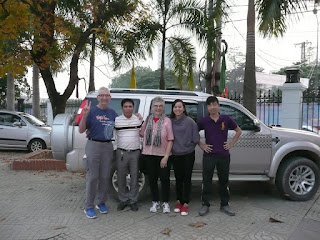Monday, January 4, 2016
Spectacular Northeastern Provinces -- People and Vistas
With the help of our friend Thiep (his company Red Lotus Tours is quite the resource!) and his wife we got to see several of the provinces of northeastern Vietnam: Vinh Phuc, Ha Giang, Coa Bang, Bac Kan, Tuyen Quang and Thai Nguyen.
This was a MOUNTAIN DRIVING trip (the driver was fearless on switchbacks, twisty 10% grade, sometimes unfinished and often 1-lane roads) with a different town destination every night. We stayed in small town hotels (the further north we went the harder the beds became) and a home stay. We ate in small restaurants often able to meet local folks, including commune and VGCL leaders. These provinces are home to many of the 54 ethnic groups of Vietnam, so we saw lots of traditional houses (use of stilts is common, wood or clay/mud or wood are usual building materials, thatched roofs, split bamboo floors -- imagine dust disappearing into the space below as a cleaning strategy!), clothing, beautiful baskets and terraced farming. Some of the houses perched on steep hills were supposedly reachable by motorbike via semi-concrete trails -- hard for me to navigate on foot.
We saw two basic types of geology in these impressive mountains -- one of beautiful red soil where there are lots of waterfalls and then one of limestone where reservoirs are critical for successful irrigation. As you explore into higher and higher valleys you find amazing small towns or villages as well as outrageous terraced farming. Earlier this area was known for opium production thanks to French colonialism and then USA-puppet leaders. There are many interesting stories about the Hmong/Khmer opium kingdom and how Ho Chi Minh reached out to build a revolutionary alliance which ultimately has lead to a diversified agriculture now producing corn, rice, tea, flowers (buckwheat!), vegetables, bananas, etc. Farm animals (the ever important cow and water buffalo along with goats, sheep, hogs and chickens) roam freely except in the limestone mountains where the stone is SHARP and treacherous for animals. Where there are sharp stones, farm animals stay very close to/in houses or "animal palaces". And I have never seen so many different types of mushrooms (along with various mysterious spices these are mostly sold to MEN.).
Other "new to us" experiences were northern traditions of tea served after eating at a separate table joining others as they finished their meal, smoking tobacco out of a LONG bamboo pipe, GIANT ferns and bamboo plants, 5 color sticky rice, water buffalo (very rich-tasting meat), sour and green pork (I did not ask for details), catfish soup, traveling Peace Road (more than 1,000 meters of MOUNTAINOUS road built by youth volunteers from all around Vietnam starting in 1975), rock walls built without mortar (kind of like New England), corn wine (takes your breath away!), Meo Vac Cow Market (see photos above), pho made with beautiful handmade noodles (see above photo), Babe Lake and National Park.
Wood/timber and brick products are another workshop-based part of the local economy. These are very rural provinces with some natural minerals (we saw tin mines), wild rivers (we saw two hydro plants under construction and one hydro power plant operating), LARGE parks but little options for industrial development. These are provinces that do have roads and electricity but are developing slowly. Closeness to border with China means some serious import/export truck traffic (real exciting for passing).
We got to visit a secondary "boarding school" and talk to one of the teachers who described the frustration of relatively few of the students graduating from high school, most focusing on learning enough to read and write Vietnamese (besides their own language). There are significant government subsidies for students who live more than 3 kilometers from school, but living away from home/rural villages 6 out of 7 days a week as well as walking the mountains to get from home to school twice a week makes education an alive issue in these provinces. A commune leader we spoke to at lunch one day also explained that if young people are willing to leave their village for a while, they aim for work in one of the large factories (foreign-owned mostly) to work hard and earn as much as possible so they can then return home to help their family build or renovate a house, invest in more farm animals, etc. While Vietnamese tourism is important in these provinces (students arrive from all over Vietnam by bus or van, rent motorbikes and then tour staying in home stays or youth hostels), it is still considered a bit rugged.
No way can we convey all the personal conversations, raunchy Vietnamese jokes, friendly greetings, gorgeous mountains and scenery, delicious foods. Our advice is buy a sweater and light jacket and warm socks to wear with your sandals and GO NOW!
Subscribe to:
Post Comments (Atom)
































No comments:
Post a Comment